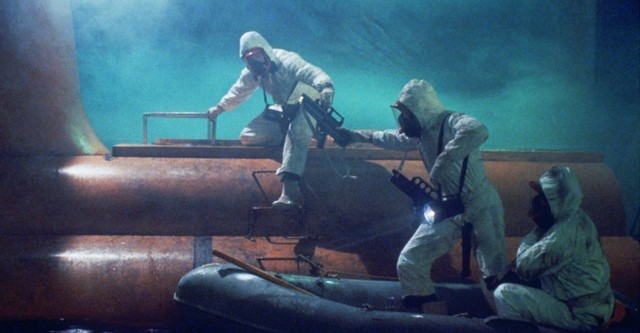Directed by Juan Piquer Simon
Written by David Coleman, Juan Piquer Simon (story)
Starring:
- Jack Scalia as Wick Hayes
- R. Lee Ermey as Capt. Phillips
- Ray Wise as Robbins
- Deborah Adair as Lt. Nina Crowley
- John Toles-Bey as Joe Kane
- Ely Pouget as Ana Rivera
- Emilio Linder as Philippe
- Tony Isbert as Fleming
Rating: ![]()
Juan Piquer Simón’s first foray into full-blown American-style genre filmmaking was a bold, if not entirely auspicious, turning point for the Valencian director—esteemed in U.S. cult circles, but curiously marginal within his native Spain. Just four years after this attempt, he would direct his penultimate film, followed by one final feature at the twilight of the twentieth century. What came next was a long and frustrating coda: a series of thwarted projects, dwindling opportunities, and a lingering melancholy over his inability to adapt more of Jules Verne’s fiction, a lifelong passion. When he passed away in 2011, he left behind a modest but distinctive body of work that continues to be reassessed by cinephiles drawn to the marginalia of horror and science fiction cinema. Within that fringe realm—part Hispanic, part Anglo-Saxon—Piquer Simón carved out an unlikely, eccentric legacy.
He was, without question, a literate student of genre. One might even argue, provocatively, that he surpassed his European contemporaries in sheer fluency with the tropes and tonalities of American B cinema. Where directors like Jess Franco, Bigas Luna, Narciso Ibáñez Serrador, or even Pedro Almodóvar folded European modernist tendencies into their exploitation sensibilities, Piquer Simón pursued something more direct and commercially calibrated. He had no interest in cultivating arthouse cachet or indulging in baroque stylizations—his aspiration was to make movies in the mold of American pulp, fast and loud and joyfully garish.
His breakthrough came in 1976 with Viaje al centro de la Tierra (Where Time Began), a fanciful adaptation of Jules Verne that drew the ire of critics but won the hearts of a younger generation newly liberated from the grip of Franco’s regime. It was a populist triumph, and a signal of the director’s intentions: to thrill, to amuse, and to deliver accessible, unpretentious adventure. From there, he sharpened his understanding of what made low-budget American genre fare so wildly profitable, embracing the visual grammar and narrative cadences of U.S. exploitation cinema with an almost anthropological precision. As his work evolved, so too did its appeal to international markets—especially in the United States, where his films became regular fixtures of the grindhouse circuit, notably on New York’s legendary 42nd Street.
What sets Piquer Simón apart from other European genre filmmakers—Lucio Fulci, Dario Argento, even the best of the Italian horror auteurs—is the seamlessness with which his work emulates the American idiom. Where Fulci’s The New York Ripper or Argento’s Tenebrae retain a distinctly European sensibility despite their English-speaking casts and U.S. settings, Piquer Simón’s horror films pass almost imperceptibly as American. This illusion stems not just from casting choices, but from a deep structural and tonal mimicry—his films speak fluent grindhouse.
The Rift (1990), his venture into underwater sci-fi horror, represents Piquer Simón’s most extravagant pastiche. A clear attempt to piggyback on the commercial momentum of The Abyss, Leviathan, and other aquatic thrillers of the late ’80s, the film operates as a pulp hybrid—Alien submerged in deep-sea peril, filtered through the earnest swagger of a Star Trek episode. Reuniting with the production team from Slugs (1988), Piquer Simón crafted a glossy, unapologetically derivative spectacle designed to capitalize on prevailing trends in American popcorn cinema.
Starring TV mainstay Jack Scalia as Wick Hayes, the submarine engineer called upon by NATO to retrieve a lost vessel (the Siren I), the film plunges into murky narrative depths alongside a crew led by R. Lee Ermey, in a tongue-in-cheek echo of his iconic turn in Full Metal Jacket. What they find beneath the ocean is, of course, predictably grotesque: genetically-engineered sea creatures that attack, infect, and annihilate. The film’s derivative nature—its almost reverent mimicry of better-known Hollywood templates—is not a liability but its principal charm. In The Rift, Piquer Simón leans fully into imitation, and by doing so crafts a deliriously enjoyable B-movie artifact that takes its schlock seriously, without ever pretending to be more than it is.
The special effects are gloriously practical, the pacing brisk, the tone at once ludicrous and sincere. Like Pieces, his infamous gore-soaked giallo-slasher, The Rift operates through a logic of pastiche—committed, knowing, and thoroughly entertaining. Its horror is cartoonish, its science laughable, and its character drama both overwrought and superfluous. And yet, somehow, it works. There’s an eerie magnetism to its visual textures and its spatial claustrophobia—its submarine setting used not for psychological depth, but for genre mechanics.
Piquer Simón’s magic lies precisely in this contradiction: how something so ordinary, so derivative, can nonetheless feel distinctive. Perhaps that is the paradox at the heart of The Rift: its conventionality is precisely what makes it compelling. It is an exploitation film in blockbuster clothing, and therein lies its unique thrill. By following the rules of the genre so strictly, by embracing its clichés without cynicism, Juan Piquer Simón made a film that is gloriously, inexplicably fun. A minor film, perhaps—but one made with major affection.










JP would have loved your review. He was indeed a genre student & true cinematic genius. So glad he is finally getting the critical attention he deserves. Writing this film for him was a dream come true for me as a novice screenwriter.
Oh, thank you very much! It means a lot to me coming from someone who knew him and worked with him. Lovely written movie, the kind of movie that could only exist in that era. I’m also a big fan of Cthulhu Mansion!